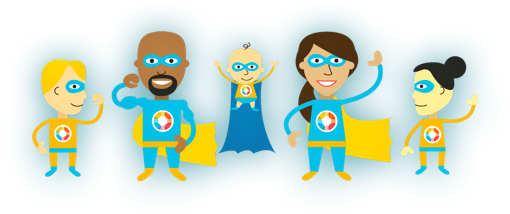Frequently Asked Questions (FAQs)
Most people have the same questions and concerns about vaccines. These are valid and deserve attention. Many concerns are rooted in misinformation found online or other sometimes well-intentioned but incorrect sources.
For even more information about immunizations, check out Plain Talk About Childhood Immunization. Now available in Russian, Spanish, and Ukrainian languages. If you ever have specific questions about the vaccine schedule, consult your doctor or healthcare provider.
Here’s a list of the common concerns that we’ve heard over the years and some information to help you make an informed decision about vaccines.

 I'm worried about the ingredients in vaccines.
I'm worried about the ingredients in vaccines.
Ingredients, also called additives, are added to vaccines to protect against disease and ensure that the vaccines are safe, sterile, and effective. Certain ingredients, called adjuvants, used in vaccines help a child’s body produce the disease-fighting antibodies it needs.
Information about specific ingredients:
- Aluminum: Many parents have heard warnings about too much aluminum in childhood vaccines from Dr. Sears’ The Vaccine Book. There is no need for parents to fear aluminum. It’s the most common metal found in nature, is part of our everyday environment, and is critical for making vaccines effective. In fact, a child gets more aluminum from breast milk or formula than from a vaccine.
- Mercury/Thimerosal: In Washington there is a state law banning thimerosal in vaccines for kids under 2 years old and pregnant women. Furthermore, since 2001, vaccines recommended by the CDC for children under six years of age are thimerosal-free, except for some formulations of the influenza (flu) vaccine, which contain a trace amount. Even if mercury were in vaccines, numerous studies show no evidence of vaccines containing thimerosal to have harmed humans aside from swelling at the site of the shot.

 I think kids get too many vaccines, too soon. Can't I just space out their shots?
I think kids get too many vaccines, too soon. Can't I just space out their shots?
Choosing to space out vaccinations leaves children at risk when they need protection the most. Children are vaccinated at a young age when they are most susceptible to the diseases they are vaccinated against. Studies show no increased risk of side effects from getting multiple vaccines at one time. Unvaccinated children are more likely to get diseases. One study showed that with whooping cough (pertussis) in particular, children who were unvaccinated were at least eight times more likely to get the disease.

 I've heard that vaccines cause autism.
I've heard that vaccines cause autism.
Vaccines do not cause autism. There have been at least 107 different studies looking for a possible connection between vaccines and autism. None have found evidence of a link. There are many theories about the causes of autism, but no definitive answers. Recent research suggests that genetic risk factors are a big contributor. The Autism Science Foundation, a nonprofit dedicated to supporting autism research, also agrees that vaccines do not cause autism. It’s a great resource to check out for more information about what causes autism.
For over a decade, parents have heard about a possible connection between vaccines and autism. In 1998, a British physician, Andrew Wakefield, published a study claiming the MMR vaccine might cause a developmental regression that looked like autism. In 2010, this study was fully retracted by its publisher, the Lancet . The study was found to be scientifically unsound because Wakefield manipulated and falsified his data. In May 2010, Great Britain’s General Medical Council revoked Wakefield’s medical license.

 We don't see these diseases anymore. Why should I vaccinate my child?
We don't see these diseases anymore. Why should I vaccinate my child?
It’s true we don’t see many of these diseases, but it doesn’t mean they are gone. It’s because vaccines have worked successfully that we have seen a decrease in these diseases in the U.S. When vaccination rates decrease, diseases can become more common in our communities. There have been measles outbreaks across the U.S. in 2014, 2015, 2016, 2017 and 2019. Nationally, the 839 cases of measles diagnosed between January and May 2019, were already the greatest number of cases confirmed in the U.S. since 1994. Washington State also experienced a major measles outbreak in 2019.
Our community’s immunity is eroding. In Washington, we have one of the highest vaccine exemption rates for school-age children in the country at 5.3%. At some schools, it is 10% or higher. These diseases are just a plane ride away. With so much international travel to countries in Europe, where measles is still active, we can’t take the chance of being unprotected at home.

 Getting sick isn't that bad, especially with chickenpox. I survived. Vaccines are not worth the risk.
Getting sick isn't that bad, especially with chickenpox. I survived. Vaccines are not worth the risk.
You never know the outcome of getting a disease. One in 10 unvaccinated children who gets chickenpox will have a complication serious enough to visit a doctor or be hospitalized. Choosing not to vaccinate is not risk free. It is simply choosing to take a different and much more serious risk – the risk of getting a vaccine-preventable disease. It’s also about more than protecting your child with a vaccine. You are protecting children and adults who could get very sick or die if they catch the disease. It’s not worth the risk of getting sick or being hospitalized. Children can be sick for weeks. Time lost from school and work is just not worth it!

 Our vaccination rates are so high that I don't need to vaccinate my kid. He's protected by herd immunity.
Our vaccination rates are so high that I don't need to vaccinate my kid. He's protected by herd immunity.
It’s true that community immunity is important for protecting children. In Washington, as of 2022-2023, our K-12 school vaccination exemption rate is 3.6% or higher at some schools and below the community immunity threshold for some diseases. When our community immunity is weakened, disease outbreaks can occur, leaving all of us at risk. Vaccinating children exposes them to weakened diseases so their bodies can build immunity and better fend off disease if there is an outbreak.
We never know who will bring illness into a community. It’s up to all of us to contribute to our community’s immunity, so we all benefit from less disease and protect those who can’t get vaccines.

 Vaccines are just moneymakers for pharmaceutical companies, doctors, and the government. Why should I risk my child's health to line someone's pockets?
Vaccines are just moneymakers for pharmaceutical companies, doctors, and the government. Why should I risk my child's health to line someone's pockets?
It’s true that pharmaceutical companies are for-profit businesses. However, they also must make significant financial investments to create lifesaving medicines. Vaccines take years of studies, testing, and work to come to market. In addition, a study published in Pediatrics shows that the costs of giving vaccines exceeded the amount that insurers and health plans paid for the service. As experts in public health, physicians and the government make recommendations based on science, not profits.

 Vaccines are not tested enough.
Vaccines are not tested enough.
Vaccines are some of the most tested and closely scrutinized medicines we take. Thousands of hours and millions of dollars go into each vaccine to make sure they are safe and effective before they’re given in doctors’ offices. Even after they are released for use, vaccines are continually tested and watched for safety. Parents and doctors can report serious side effects on the Vaccine Adverse Events Reporting Systems (VAERS) website.

 I’ve heard that people can still get sick with the disease they’ve been vaccinated against.
I’ve heard that people can still get sick with the disease they’ve been vaccinated against.
Even though vaccines are extremely effective, they are not perfect. For example, a vaccine that is 90% effective means that 1 in every 10 people who are vaccinated will not be fully protected from the disease. When a disease affects a community, unprotected people are more likely to be infected. This includes those who were not vaccinated and the 10% of people who were vaccinated but did not get full protection.
Vaccinated people who get the disease can experience a milder form of the disease. For example, for whooping cough (pertussis), we know that vaccinated children who get sick have fewer symptoms, are sick for a shorter time, and are less likely to spread the disease to others. We need more than one dose of most vaccines to get the protective immunity. Some vaccines require booster doses throughout a lifetime to maintain protection.

